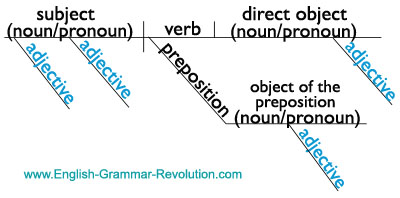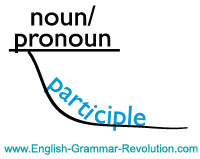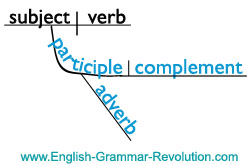SALE! USE CODE DIGITAL30 AT CHECKOUT FOR 30% OFF DIGITAL COURSES & EBOOKS
SALE! USE CODE DIGITAL30 AT CHECKOUT FOR 30% OFF DIGITAL COURSES & EBOOKS
What are participles & participial phrases?
What are participles & participial phrases?
Participles are forms of verbs that end in -ing, -en, -d, -t, or -n.
As you might expect, participles can function as verbs, but they can also do something surprising: they can function as adjectives. (Plot twist!) In this lesson, we'll be focusing on participles as adjectives.
The students are laughing. --> verb (It's naming an action.)
The laughing students couldn't calm down. --> adjective, participle (It's modifying students.)
Words that are formed from verbs but don't act as verbs are called verbals. There are two other kinds of verbals: gerunds and infinitives.
Let's Review Adjectives
In order to understand what participles do, we need to review what adjectives are.
- Adjectives are words that modify nouns.
- Nouns are words that name people, places, things, or ideas.
Hand me the blue marker.
Blue is an adjective. It's describing the noun marker.
I love wearing this soft sweater.
Soft is an adjective. It's describing the noun sweater.
Now Let's Look At Participles
Remember that participles are verb forms acting as adjectives. Let's look at some examples. Try to figure out how each one is a participle. (That means you should notice how each one is made from a verb but is acting as an adjective. Can you figure out what noun each participle is modifying?)
The shooting star flashed across the night sky.
Shooting is a participle. It's formed from the verb shoot, it ends in -ing, and it's modifying the noun star.
Crying babies can be very loud.
Crying is a participle. It's formed from the verb cry, it ends in -ing and it's modifying the noun babies.
I don't like frozen food.
Frozen is a participle. It's formed from the verb freeze, it ends in -en, and it's modifying the noun food.
I love burnt toast!
Burnt is a participle. It's formed from the verb burn, it ends in -t, and it's modifying the noun toast.
Since these act as adjectives, they're diagrammed in a very similar way to how adjectives are diagrammed.
Notice that we diagram adjectives on a slanted line underneath the word that the adjective is modifying.

When we diagram participles, we also put them a slanted line under the noun that they are modifying, but we add a curve to the line so that we can easily see it's a participle and not an adjective.


The filtered water tastes delicious.
Participial Phrases (& Participle Clauses)
Phrases are groups of words, without both a subject and a verb, functioning as a single part of speech.
Participial phrases consist of a participle along with all of its modifiers and complements. "Modifiers and complements" refer to any adjectives, adverbs, predicate nouns, predicate adjectives, direct objects, and more.
Here are three examples. Notice that each phrase is acting as an adjective. (That means that each phrase is modifying a noun.)
Babies crying in the night bother me.
- The participial phrase is crying in the night.
- Crying is the participle, and in the night is an adverbial prepositional phrase modifying crying. The whole thing is functioning as one unit.
- It modifies the noun babies.
Food frozen for over five years tastes icky.
- The participial phrase is frozen for over five years.
- Frozen is the participle, and for over five years is an adverbial prepositional phrase modifying frozen. The whole thing is functioing as one unit.
- It is modifies the noun food.
Throwing rocks across the water, my friend smiled.
- The participial phrase is throwing rocks across the water.
- Throwing is the participle, rocks is the participle's direct object, and across the water is a prepositional phrase modifying throwing. The whole thing is functioning as one unit.
- It modifies the noun friend.
What is a participle clause?
The short answer is that a participle clause is simply a different name for a participial phrase. Use whichever you like best.
I find that the term participle clause can be confusing to people because we typically define clauses as groups of words that contain both a subject and a verb, and participial phrases (participle clauses) do not contain a subject. (People who use the term participle clause may think of the word that the participle is modifying as the "subject" of the participle clause.)
However, it's important to recognize that some schools of thought define terms a bit differently than we do here at Grammar Revolution. They would point out the difference between a clause with a finite verb (the main verb used in an independent and dependent clause) and a "clause" with a nonfinite verb (verbs that are not functioning as main verbs, including verbs that act as other parts of speech). I use the term verbal instead of nonfinite clause to refer to verbs that act as other parts of speech.
Whew! That was kind of complicated. I hope that it made sense!
Reduced Adjective Clause?
Reduced adjective clauses refer to participial phrases that have been formed by "reducing" dependent adjective clauses. Let's look at an example.
We can take a dependent adjective clause (who was watering her plants) and turn it into a participle by removing the subject (who) and helping verb (was). We are left with a participial phrase (watering her plants). Since this process involves "reducing" the clause, we call the participial phrase that we created a "reduced adjective clause."
Diagramming Participial Phrases
When diagramming these, start by identifying the participle and the noun that it is modifying.
You already know that you diagram it by putting it on a curved, slanted line under the noun that it modifies.
After that, find out what the rest of the phrase consists of and diagram it accordingly.
I'll walk you through the steps using this sentence:

Throwing rocks across the water, my friend smiled.
- Step 1: Find the participle. (throwing)
- Step 2: Find the noun that it modifies. (friend)
- Step 3: Find the rest of the phrase. (rocks across the water)
- Step 4: Figure out what the rest of the phrase is doing.
This is where your other grammar knowledge comes into play. In order to diagram this, you need to know that rocks is a direct object and across the water is a prepositional phrase.
This prepositional phrase is modifying throwing.
That means that we diagram the prepositional phrase underneath throwing.
Diagram rocks as if throwing is a normal verb.

Dangling?
When a participial phrase doesn't have a noun or pronoun to modify, it dangles. This is called a dangling participle. Click on that link to learn more.
If you'd like to teach or learn grammar the easy way—with sentence diagrams—check out our Get Smart Grammar Program.
It starts from the very beginning and teaches you grammar and sentence diagramming in easy, bite-size lessons.

Hello! I'm Elizabeth O'Brien, and my goal is to get you jazzed about grammar.
Elizabeth,
I am ecstatic with the grammar program. I am working on lesson 6
already. I just received your books, and they are fabulous. Thank you,
thank you. I know I will be the grammar queen by the end of the summer
holidays.
- Clare
This is original content from https://www.english-grammar-revolution.com/participles.html
Our Free Guide Gives You A Fun Way
To Teach And Learn The Basics v

Elizabeth O'Brien is the creator of Grammar Revolution.
Her lessons are guaranteed to give you more confidence in your communication skills and make you smile. :)

